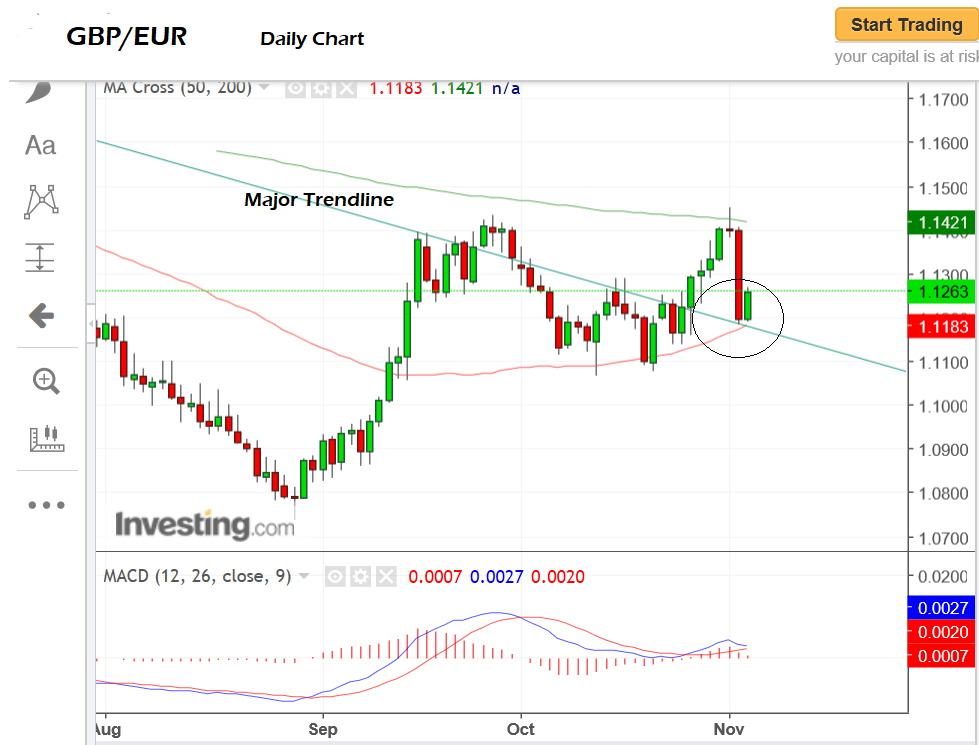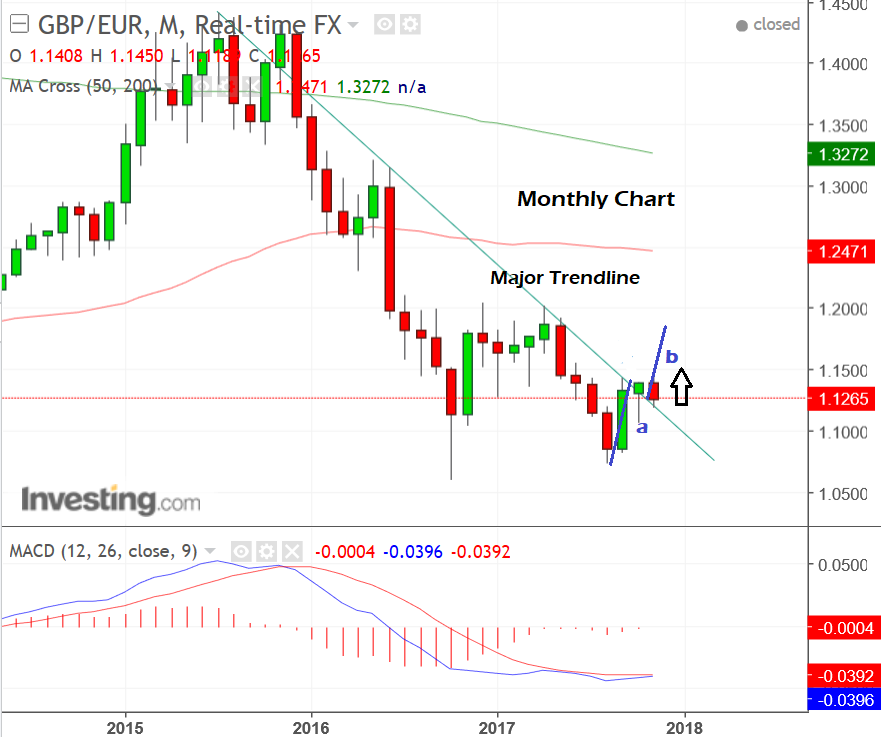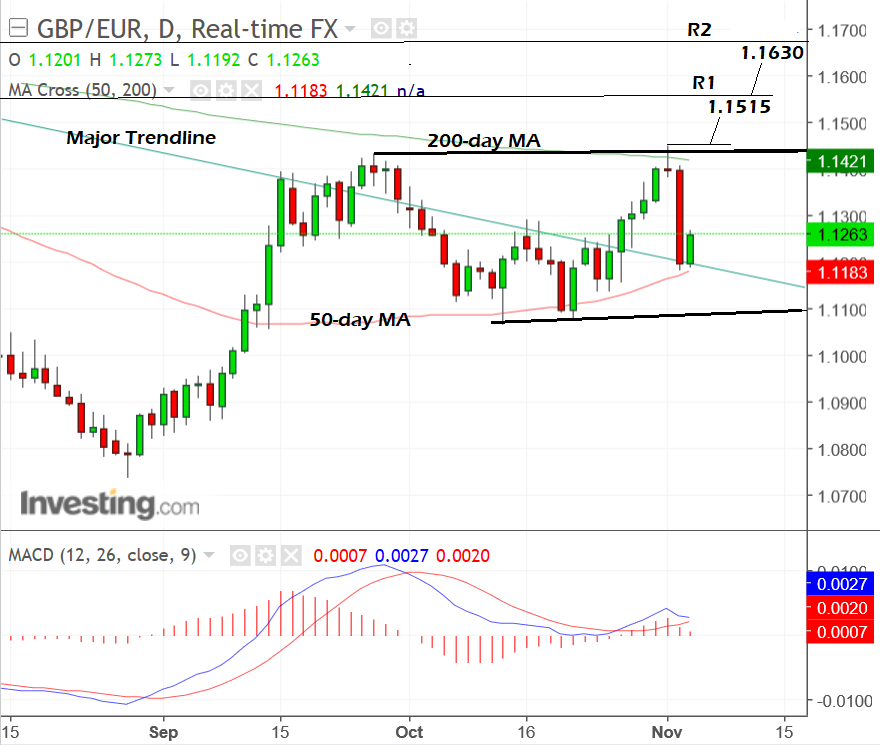5-Day Pound-to-Euro Rate Forecast: Still Bullish on Longer-Term Timeframes, Brexit Negotiations Dominate Agenda in Week Ahead
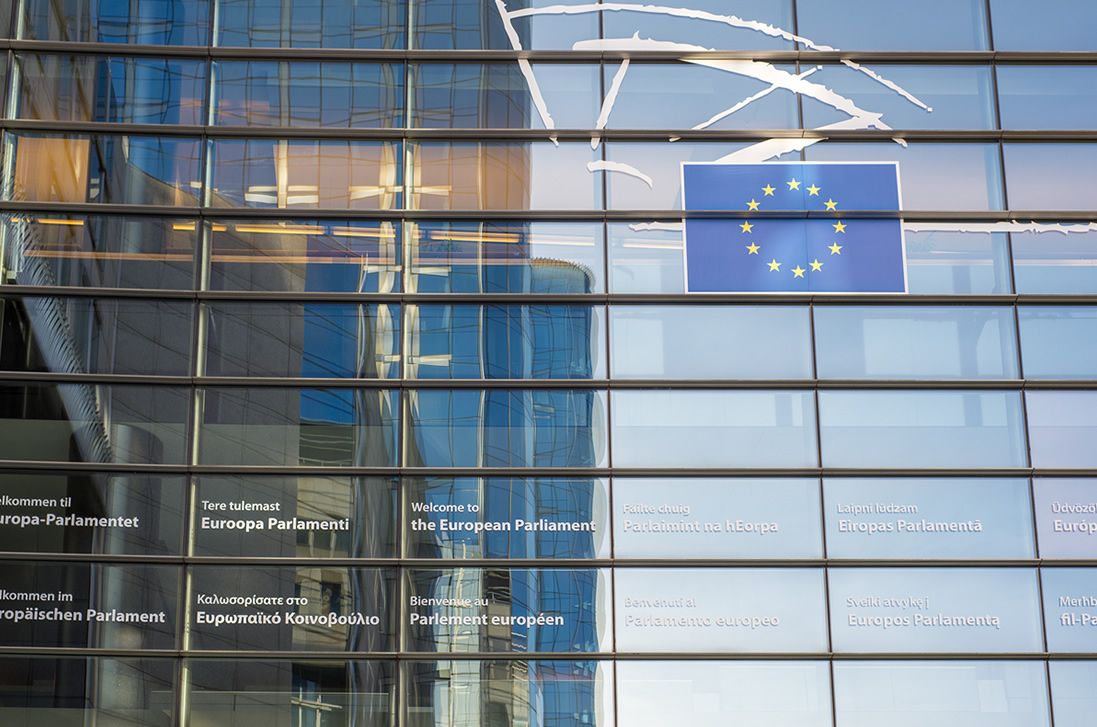
The British Pound has seen heightened volatility of late but is still positively aligned against the Euro over the longer-term as Brexit negotiations form the fundamental focus for the currency in the coming week.
The Pound-to-Euro exchange rate has pulled back down to the 1.12s after rising up to a peak of 1.1454 in the run-up to the Bank of England rate meeting held on November 2.
The Bank raised interest rates by 0.25% to 0.50% for the first time in 10 years as per market expectations. Sterling did fall sharply on the day as markets appear to have fully priced the interest rate rise and traders appear to have 'sold the fact' in a technical reaction to the announcement.
Concerning the outlook, our technical studies of the charts confirm GBP/EUR has now found support at a major multi-year trendline which the exchange rate previously broke above back in September and then again in October.
On the longer-term monthly chart, the exchange rate looks as if it has broken clearly above the trendline, which is a very bullish sign for the pair.
The usual method for determining how far prices will go after a break of the trendline is to take the move prior to the break, labeled 'a' on the chart below, and extrapolate it above the trendline ('b') to find the extent of the expected post-break move.
On the monthly chart, this indicates that the move would probably rise up to a target at just below 1.2000.
The daily chart, however, is not as bullish as the monthly, after the steep decline on Thursday following the BOE rate meeting brought the exchange rate decisively lower.
The question now is, is this a signal that the trend has changed and prices will go even lower?
It is difficult to say at the moment because on the one hand long red down days like last Thursday's are normally a precursor to more weakness but on the other hand, Thursday's move was stopped by the formidable obstacle of the major trendline which is unlikely to be broken.
All we can confidently say at the moment is that on the daily chart the exchange rate is trading in the middle of a sideways range with a floor at 1.11 and a ceiling at 1.14; and so would be expected to continue sideways.
Taking the evidence from the two charts together, however, suggests that the sideways trend will eventually break higher fulfilling the bullish promise of the monthly chart.
Such a break would be confirmed by a move above the 1.1454 November 1 highs, with an initial target at 1.1515 at the R1 monthly pivot.
Monthly pivots are levels which often act as obstacles to the main trend and traders often use them to trade against the direction of the main trend in an effort to profit from the pull-backs which often occur.
The breakout from the range would be expected to break above the R1 pivot eventually, however, because range breakouts will normally rise the same distance as the height of the range at its widest point extrapolated higher from the point of the break.
In this case, it suggests the pair will rally about 3 cents following the break with a final target at about 1.1700, however, the R2 monthly pivot at 1.1630 provides a more likely end-point due to it being a line of formidable resistance.
Get up to 5% more foreign exchange by using a specialist provider by getting closer to the real market rate and avoid the gaping spreads charged by your bank for international payments. Learn more here.
Events and Data for the Pound in the Coming Week
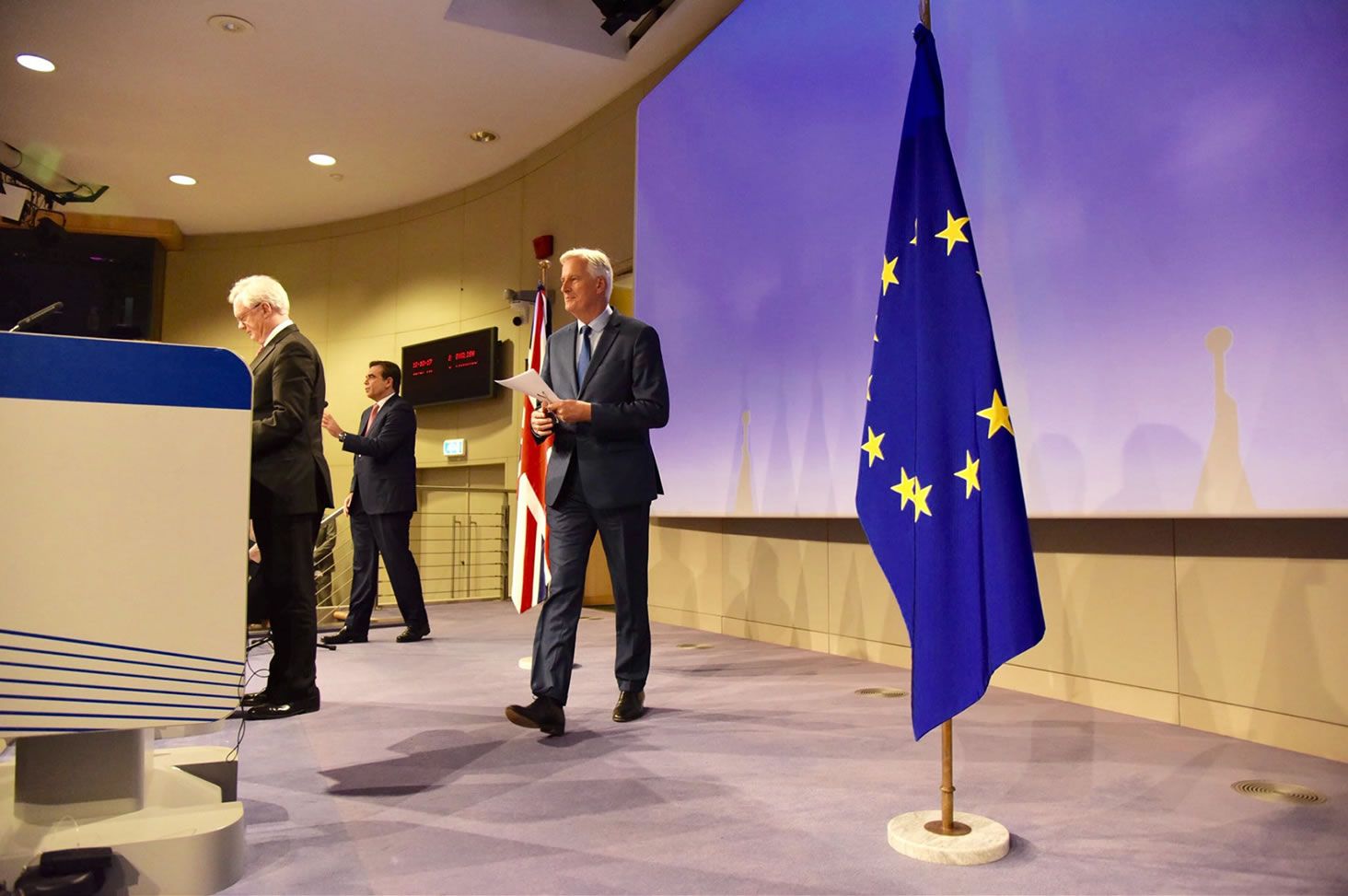
Above: Michel Barnier and David Davis. (C) European Commission.
Last week saw the Bank of England take the momentous step to raise interest rates for the first time in 10-years.
Yet no sooner had the rate hike been announced than the market moved onto the next topic of discussion, which is whether or not the hike was a one-off or a part of a series.
The main determining factor appears to be Brexit uncertainty - if talks go smoothly the BoE is more likely to raise rates again - if not then they will probably err on the side of caution and leave the one rise until a clearer picture of what post-Brexit Britain will be like emerges.
Remember the rule of thumb is higher interest rates = a stronger Pound.
Governor @bankofengland Mark Carney explains how the "Brexit effect" has limited the strength of economic growth. #Peston pic.twitter.com/yI0a2U5lCS
— Peston on Sunday (@pestononsunday) November 5, 2017
"We agree that a deal is the most likely outcome, and based on this we believe that market expectations for a cumulative 0.5% of additional interest rate rises by mid-2020 look low. Rather we think the MPC would like to follow a path similar to that of the Federal Reserve, which has raised rates by a cumulative 0.75% since its initial hike in December 2015," says Pimco Analyst Mike Amey.
Brexit negotiations commence once again in the coming week with all eyes turning to Friday's press conference to be hosted by the UK's David Davis and the EU's Michel Barnier for clues on progress.
Markets will want to see signs of progress that will allow the progression of talks from issues surrounding the divorce to that of trade. Of particular concern is the securing of a transitional deal, widely expected to last two years.
Businesses want certainty and the transitional period will be critical to providing the stability required to make investment decisions.
“Given the Government’s ambitious timetable, to agree on a transitional period early next year and the future relationship altogether by next October, it is crucial for the second phase of talks to start in January,” says Andrew Wishart, UK Economist with Capital Economics.
All in all, this is to say that in the week ahead news about Brexit will remain a high priority for currency dealers.
As far as the hard-data front goes, it is a relatively quiet week with no tier one releases on the radar.
The first release is the BRC Retail Sales Monitor released just after midnight on Tuesday, November 7.
This will provide an up-to-date snapshot of the most recent retail sales activity.
Next, we have Halifax House Prices out at 08.30 on Tuesday and is followed by the House Price Balance from the Royal Institute of Chartered Surveyors, just after midnight on Wednesday, November 8.
On Friday Industrial and Manufacturing Production data for September is released at 9.30, with the former expected to come out at 0.3% versus 0.2% previously, and later suggesting a 0.3% versus 0.4% previously.
The Trade Balance is released at the same time and is expected to show the deficit narrow to -12.8bn from over -14bn previously.
Events and Data for the Euro
Politics could be a mover of the Euro in the week ahead although the main flash-points are regional thus probably won't cause substantial volatility for the single currency.
Regional elections in Sicily on Sunday are being presented as a dress rehearsal for the bigger Italy-wide elections in May 2019, and therefore, could be a barometer to suggest their outcome.
To effect a move in the Euro, Sicily would have to vote overwhelmingly for the anti-EU Five Star party - a prospect which looks increasingly unlikely given expectations that former Prime Minister Silvio Berlusconi is likely to make a comeback more than Five Star.
Election rules were changed recently making it harder for one party to achieve outright rule and given Five Star refuses to form coalitions with any other parties it is unlikely to gain power and threaten to take Italy out of the EU.
Catalonia's bid for independence appears to have been snuffed out after Madrid introduced direct rule and dissolved the Catalan regional government.
Arrest warrants have now also been issued for the top players in the Catalan parliament, including president-in-exile Carles Puigdemont.
Whilst the crisis in Catalonia appears to have eased, there is still the potential for outbreaks of protest or surprise twists and turns as ultimately proven by protests this weekend in the Basque country in support of Catalonian independence, but ultimately the chances of that causing major volatility for the Euro are now lower.
On the hard data front, the first main release for the Euro in the coming week is Retail Sales at 10.00 on Tuesday, November 7, which is expected to show a 0.6% rise from -0.5% previously.
Apart from that, there is German Industrial Production at 7.00 on Tuesday, November 7, and the final estimate for October Services PMI released on Monday at 9.30.

